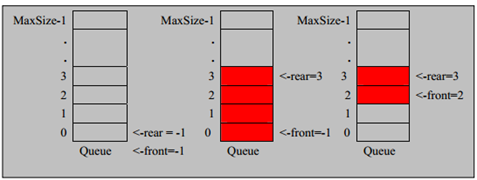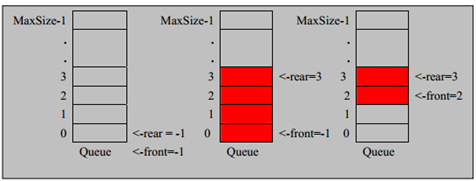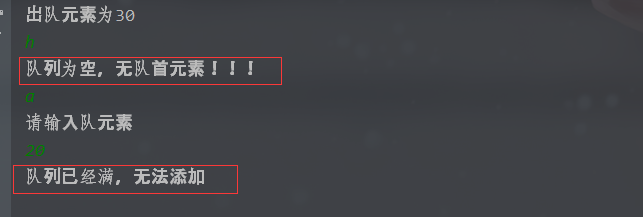队列
一、应用场景
银行排队案例

二、队列介绍
-
队列是一个有序列表,可用 数组 或者 链表 来实现
-
遵循先入先出的原则,即:先存入队列的数据,要先取出。后存入的要后取出
-
示意图

三、实现思路
数组模拟队列
-
队列本身是有序列表,若使用数组的结构来存储队列的数据,则队列数组的声明如下图, 其中 maxSize 是该队列的最大容量。
-
因为队列的输出、输入是分别从前后端来处理,因此需要两个变量 front及 rear分别记录队列前后端**的下标,front 会随着数据输出而改变,而 rear则是随着数据输入而改变,如图所示:

四、代码实现(Java)
数组模拟队列 ArrayQueue.java
/**
* 使用数组模拟队列-编写一个ArrayQueue类
*/
class ArrayQueue {
/**
* 表示数组的最大容量
*/
private int maxSize;
/**
* 队列头
*/
private int front;
/**
* 队列尾
*/
private int rear;
/**
* 模拟队列
*/
private int[] arr;
/**
* 创建队列的构造器
*/
public ArrayQueue(int arrMaxSize) {
this.maxSize = arrMaxSize;
arr = new int[maxSize];
// 指向队列头部,指向队列头的前一个位置
front = -1;
// 指向队列尾部,指向队列尾的位置(具体位置,包含队列尾部)
rear = -1;
}
/**
* 判断队列是否是满的
*/
public boolean isFull() {
// 自己写的判断逻辑
/* if(rear == (maxSize - 1)){
return true;
}
return false;*/
// 韩老师写的判断逻辑
return rear == (maxSize - 1);
}
/**
* 判断队列是否为空
*/
public boolean isEmpty() {
return front == rear;
}
/**
* 添加数据到队列(入队)
* 1、先判断队列是否已经满了
* 2、然后在确定是否进行添加
*/
public void addQueue(int o) {
// 先判断是否已经满了
if (!isFull()) {
++rear;
arr[rear] = o;
System.out.println("成功加入!");
return;
}
System.out.println("队列已经满,无法添加");
}
/**
* 获取队列数据(出队)
* 1、先判断队列是否为空
* 2、然后在确定是否进行出队
*/
public int getQueue() {
if (!isEmpty()) {
// 头部后移
++front;
return arr[front];
}
// 抛出异常,不要写 return -1;这种 throw直接就结束了,所以不用再写 return 了
throw new RuntimeException("队列为空,不能出队!!!");
}
/**
* 展示队列所有数据
*/
public void showQueue() {
if (!isEmpty()) {
for (int i = front + 1; i <= rear; i++){
System.out.printf("arr[%d] = %dt",i + 1,arr[i]);
}
return;
}
System.out.println("队列为空,无数据可展示!!!");
return;
}
/**
* 展示队头
*/
public int headQueue(){
if(!isEmpty()){
return arr[front + 1];
}
throw new RuntimeException("队列为空,无队首元素!!!");
}
}
主方法
package com.fafa.queue;
import java.util.Scanner;
/**
* 使用数组模拟实现队列
*
* @author Sire
* @version 1.0
* @date 2021-12-29 16:17
*/
public class ArrayQueueDemo {
public static void main(String[] args) {
// 创建一个队列
ArrayQueue arrayQueue = new ArrayQueue(3);
// 用户选择键
char key = ' ';
// 循环判断
boolean loop = true;
Scanner sc = new Scanner(System.in);
menu();
while(loop){
key = sc.next().charAt(0);
switch (key){
// 入队
case 'a':
System.out.println("请输入队元素");
int a = sc.nextInt();
arrayQueue.addQueue(a);
break;
// 出队
case 'g':
try {
int g = arrayQueue.getQueue();
System.out.println("出队元素为" + g);
} catch (Exception e) {
System.out.println(e.getMessage());
}
break;
// 显示全部
case 's':
arrayQueue.showQueue();
break;
// 显示头部
case 'h':
try {
int h = arrayQueue.headQueue();
System.out.println("队首元素为:" + h);
} catch (Exception e) {
System.out.println(e.getMessage());
}
break;
// 退出程序
case 'e':
sc.close();
loop = false;
break;
default:
break;
}
}
System.out.println("程序退出");
}
public static void menu(){
System.out.println("a:入队");
System.out.println("g:出队");
System.out.println("s:显示全部");
System.out.println("h:显示队首");
System.out.println("e:退出程序");
}
}
上述代码存在的问题
问题就是,数组空间无法实现复用,没有形成一个环状( 取 模 ),就是已经入队的位置,即使出队后,也无法继续利用其位置添加新的元素了

五、代码优化
1、优化思路
对前面的数组模拟队列的优化,充分利用数组.
因此将数组看做是一个环形的。(通过取模的方
式来实现即可)
思路如下:
- front 变量的含义做一个调整: front 就指向队列的第一个元素, 也就是说 arr[front] 就是队列的第一个元素
front 的初始值 = 0
- rear 变量的含义做一个调整:rear 指向队列的最后一个元素的后一个位置. 因为希望空出一个空间做为约定.
rear 的初始值 = 0
-
当队列满时,条件是 (rear + 1) % maxSize == front 【满】
-
对队列为空的条件, rear == front 空
-
当我们这样分析, 队列中有效的数据的个数 (rear + maxSize - front) % maxSize // rear = 1 front = 0
其实本质上就是rear - front 的绝对值,加maxSize就是为了避免负数的情况
-
将 rear 后移,这里必须要考虑取模(防止数组下标越界)
rear = (rear + 1) % maxSize;
front同理;
- 我们就可以在原来的队列上修改得到,一个环形队列
2、实现代码
CircleArrayQueue.java
/**
* 使用数组模拟环形队列-CircleArrayQueue类
*/
class CircleArrayQueue {
/**
* 表示数组的最大容量
*/
private int maxSize;
/**
* front 队列的第一个元素
*/
private int front;
/**
* rear 指向队列的最后一个元素的后一个位置. 因为希望空出一个空间做为约定.
*/
private int rear;
/**
* 模拟队列
*/
private int[] arr;
/**
* 创建队列的构造器
*/
public CircleArrayQueue(int arrMaxSize) {
this.maxSize = arrMaxSize;
arr = new int[maxSize];
// front 队列的第一个元素
front = 0;
// rear 指向队列的最后一个元素的后一个位置. 因为希望空出一个空间做为约定.
rear = 0;
}
/**
* 判断队列是否是满的
*/
public boolean isFull() {
return (rear + 1) % maxSize == front;
}
/**
* 判断队列是否为空
*/
public boolean isEmpty() {
return front == rear;
}
/**
* 添加数据到队列(入队)
* 1、先判断队列是否已经满了
* 2、然后在确定是否进行添加
*/
public void addQueue(int o) {
// 先判断是否已经满了
if (!isFull()) {
arr[rear] = o;
// 将 rear 后移,这里必须要考虑取模(防止数组下标越界)
rear = (rear + 1) % maxSize;
System.out.println("成功加入!");
return;
}
System.out.println("队列已经满,无法添加");
}
/**
* 获取队列数据(出队)
* 1、先判断队列是否为空
* 2、然后在确定是否进行出队
*/
public int getQueue() {
if (!isEmpty()) {
// 这里需要分析出 front 是队列首个元素(并非数组第一个)
// 1、temp用来存储arr[front] 的值,便于将front进行增加操作
int temp = arr[front];
// 2、front也要进行相加和取模操作(环形)
front = (front + 1) % maxSize;
// 3、返回 temp 保存的 arr[front] 的值
return temp;
}
// 抛出异常,不要写 return -1;这种 throw直接就结束了,所以不用再写 return 了
throw new RuntimeException("队列为空,不能出队!!!");
}
/**
* 展示队列所有数据
*/
public void showQueue() {
if (!isEmpty()) {
//思路: 从front开始遍历,遍历多少个元素(也就是有效的元素个数)
// 其实有效个数就是 rear - front的绝对值,这里加maxSize是为了抵消负数
/** 自己写的 **/
/* int n = (rear + maxSize - front) % maxSize;
int count = 0;
int i = front;
while (count < n) {
System.out.printf("arr[%d] = %dt", i % maxSize , arr[i % maxSize]);
i++;
count++;
}*/
/** 韩老师写的 **/
for (int i = front; i < front + getValidSize(); i++) {
System.out.printf("arr[%d] = %dt", i % maxSize, arr[i % maxSize]);
}
System.out.println();
return;
}
System.out.println("队列为空,无数据可展示!!!");
return;
}
/**
* 计算数组的有效个数
*/
public int getValidSize() {
// 其实有效个数就是 rear - front的绝对值,这里加maxSize是为了抵消负数
return (rear + maxSize - front) % maxSize;
}
/**
* 展示队头
*/
public int headQueue() {
if (!isEmpty()) {
return arr[front];
}
throw new RuntimeException("队列为空,无队首元素!!!");
}
}
主方法(测试)
public class CircleArrayQueueDemo {
public static void main(String[] args) {
// 测试环形数组
// 创建一个队列 这里实际可用参数只有 4 个,因为最后一个空间要作为约定
CircleArrayQueue circleArrayQueue = new CircleArrayQueue(5);
// 用户选择键
char key = ' ';
// 循环判断
boolean loop = true;
Scanner sc = new Scanner(System.in);
menu();
while (loop) {
key = sc.next().charAt(0);
switch (key) {
// 入队
case 'a':
System.out.println("请输入队元素");
int a = sc.nextInt();
circleArrayQueue.addQueue(a);
break;
// 出队
case 'g':
try {
int g = circleArrayQueue.getQueue();
System.out.println("出队元素为" + g);
} catch (Exception e) {
System.out.println(e.getMessage());
}
break;
// 显示全部
case 's':
circleArrayQueue.showQueue();
break;
// 显示头部
case 'h':
try {
int h = circleArrayQueue.headQueue();
System.out.println("队首元素为:" + h);
} catch (Exception e) {
System.out.println(e.getMessage());
}
break;
// 退出程序
case 'e':
sc.close();
loop = false;
break;
default:
break;
}
}
System.out.println("程序退出");
}
/**
* 菜单方法
*/
public static void menu() {
System.out.println("a:入队");
System.out.println("g:出队");
System.out.println("s:显示全部");
System.out.println("h:显示队首");
System.out.println("e:退出程序");
}
}
最后
以上就是谨慎柠檬最近收集整理的关于Day02数组队列和环形数组队列的全部内容,更多相关Day02数组队列和环形数组队列内容请搜索靠谱客的其他文章。








发表评论 取消回复